navigation

Originally published May 1, 2019, updated November 10, 2021
Correctly pricing your products is fundamental to any business. But how do you know if your price accurately reflects its value and demand? Price too low and you leave money on the table; price too high and you lose sales. The optimal B2B eCommerce pricing strategy will always depend on the product, the customer, and the market. Successful B2B eCommerce companies tailor their price strategies to maximize profit per customer and product.
This article will cover the variables impacting a product price, different B2B pricing strategies, B2B pricing strategy examples, and common mistakes. As a bonus, you’ll learn how advanced eCommerce solutions can help you successfully implement and manage your pricing approach.
Key Variables in B2B Pricing Strategies
Many variables influence the optimal price for a product. Competition, the general economic environment, perceived value, and emotional factors are just a few to consider. In addition, the product, the customer, and the market all have unique price sensitivities to consider.
Constructing an algorithm to accurately factor in all variables for your B2B pricing model is difficult, but by considering the heuristics for the product, customer, and market price sensitivities, you can improve performance for each transaction.
Three Product Types
Different products have different price sensitivities. Within your product line, you may have premium products, commodity-type products, and custom-type products.
Margins on your commodity-type products are typically lower, and they tend to be very price-sensitive. They should be priced differently than your premium or custom products, which are less price-sensitive and have higher margins.
B2B eCommerce pricing strategy should reflect these heuristics. Begin setting prices by correctly identifying the product category based on price sensitivity.
Your Customer’s Profile
Every customer is unique and has their own price sensitivity. Large volume customers tend to be more price-sensitive than smaller volume customers. Customers who purchase frequently are also more price-sensitive than less frequent buyers. In addition, different customers have an individual perception of the value of support and brand relationship. Customers who place a high value on relationship and product support are less price-sensitive than those who perceive these elements to be less significant. It also helps to know where your customers are in their own business cycle and whether speedy delivery is something they’d be willing to pay extra for.
Market Growth Dynamics
Each market has its own level of sensitivity, which greatly depends on market growth numbers and market saturation. Dynamic growth and low saturation allow for better margins, while a plateauing market entails increased price sensitivity. If your products serve multiple markets, you must consider the sensitivity of the market as well as the product. The price environment of your industry is a variable as well. In some markets, movement by an industry price leader can impact prices for all market players.
Aligning Economic and Emotional Value
Willingness-to-pay isn’t just a factor in the B2C marketplace. B2B companies need to consider it as well. It’s the sweet spot where economic and emotional values intersect to create perceived value. If you are targeting customers that are innovators and early adopters, they are less price-conscious. This segment is driven by the high emotional value of gaining a competitive edge and supports a high economic value.
On the opposite end of the spectrum are buyers that place no emotional value on your product. The purchase has low to no emotional value and willingness-to-pay is low as well. You must carefully match their perceived economic value to your price.
But the vast majority of your market lies in the middle, meaning that buyers are rational overall, but can sometimes be subject to emotional surges. For these, you must price according to the economic drivers specific to their niche. Your price approach must support their own pricing metrics and value models.
B2B Pricing Strategies for eCommerce
There are several different B2B pricing methods that you can apply to your eCommerce business. Let’s explore the four most popular B2B pricing tactics, alongside their advantages and disadvantages.
1. Cost-plus pricing
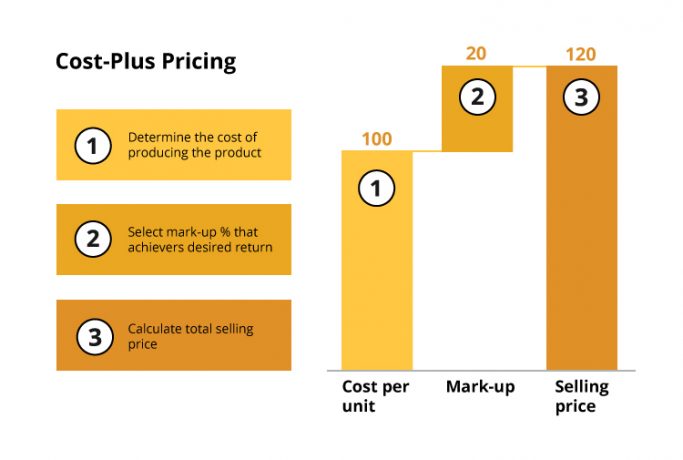 Too often, cost-plus pricing is the default strategy. It’s easy because it doesn’t require market research or understanding the psychology of customers or competitors. It is also inefficient and does not maximize profits.
Too often, cost-plus pricing is the default strategy. It’s easy because it doesn’t require market research or understanding the psychology of customers or competitors. It is also inefficient and does not maximize profits.
Cost-plus pricing assigns the same margin to every customer even though we know that customers have different price sensitivities and emotional values. You can effectively use this strategy to set price and margin floors. These floors can be a great starting point for developing a value-based pricing strategy.
Pros:
Companies choose this method for the relative ease of calculating prices. Also, in the B2B world, where negotiations are common, cost-plus pricing makes it easy to offer lower markup to companies who want to negotiate better prices.
Cons:
Despite its popularity, the cost-plus pricing strategy for B2B customers often lacks customer engagement and initiative.
Opt for this strategy only when:
- You don’t have enough resources/time to do market, customer, or competitor research.
- You need to focus more on other processes or business areas, like inventory management or marketing.
- There isn’t too much variation in price competition for your product line.
2. Competitive pricing
Competitive pricing is essentially price plagiarism. You look at what the competition is doing and price your products accordingly. Using this strategy places no more value on your products or brand than that of your competitors.
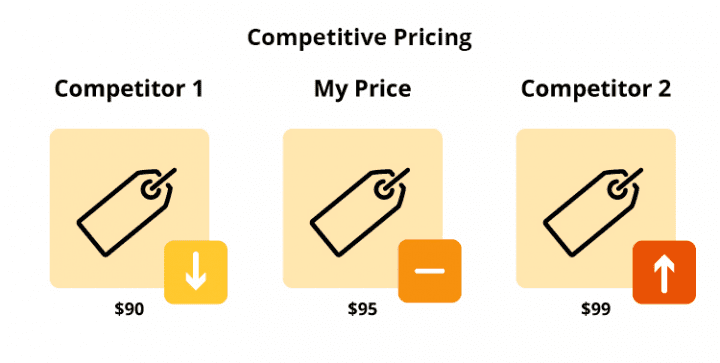 Pros:
Pros:
Like the cost-plus pricing model, competition-based pricing can be simple to implement. Plus, there is a lower risk associated with this strategy. By setting prices similar to what is already on the market, you won’t scare customers away with a price that is too high. And, at the same time, you also reduce the chances of undervaluing your products with a low price.
Cons:
Setting up prices using competitive pricing can lead to inaccurate evaluation of your service or product. If you are not careful, you may miss the opportunity to sell your products at a higher price, thus losing profits, or simply get caught up in a price war with competitors.
3. Value-based pricing
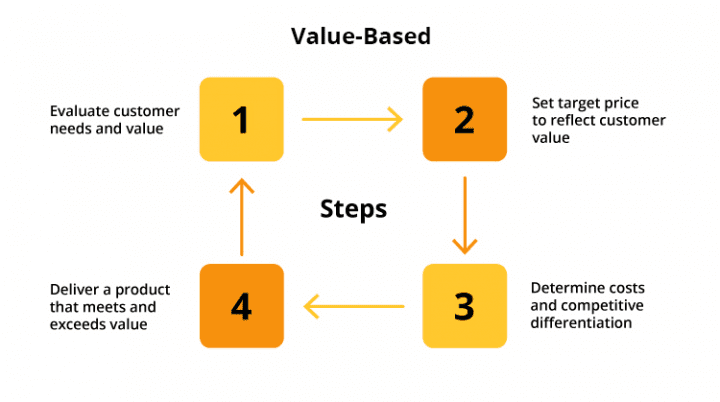 Value-based pricing takes time and data but it maximizes profit per customer. By pricing per customer, per product, and per market, you get a price that is both profitable for you and enticing for customers.
Value-based pricing takes time and data but it maximizes profit per customer. By pricing per customer, per product, and per market, you get a price that is both profitable for you and enticing for customers.
For example, large customers with tremendous buying power are priced differently than small customers who make infrequent purchases. Unlike static cost-plus or competitive pricing strategies, value-based pricing is more dynamic and because it is more customer-based, it can also improve B2B eCommerce marketing efforts.
After all, once you understand your high-value customers, you can grow by targeting leads that resemble these customers.
Pros:
With value-based pricing, you’re charging the highest price possible from the start, because you don’t base it on the cost of materials or the competition. This means that you’re more likely to increase profits as time goes on and better understand what your customers value.
Cons:
Compared to other types of business to business pricing strategies, this one typically requires more extensive research than other price structures. You’ll need a deep understanding of the target market to determine how much customers are willing to pay for what you’re offering.
4. Dynamic pricing
The dynamic pricing strategy is based on the mechanism of adjusting prices in real-time when specific factors come into play. It could be used to match changes in demand, market or currency fluctuations, to price-match competitors, or reflect your customers’ perceived willingness to pay. The key goal of dynamic eCommerce pricing is to apply the right price at the right time for a specific customer.
Some of the examples of the dynamic pricing strategies include:
- Time-based dynamic pricing allows you to adjust prices in line with demand at a certain time of the day, week, or year.
- Segment-based dynamic pricing means offering the same product at different prices, depending on factors such as customer location or customer value. For example, high-value customers can be offered higher prices.
- Market-based dynamic pricing enables price changes according to market conditions such as how much demand there is for a particular product at that time.
- Penetration pricing is when companies set prices that are below the market standard and increase them gradually over time, allowing future customers to get familiar with the brand and its products.
- Conversion-based dynamic pricing allows you to configure your eCommerce solution to track the conversion rate on your website and adjust prices to achieve maximum profitability. For example, you can charge more when conversion rates are unusually high, and less when conversion rates are particularly low.
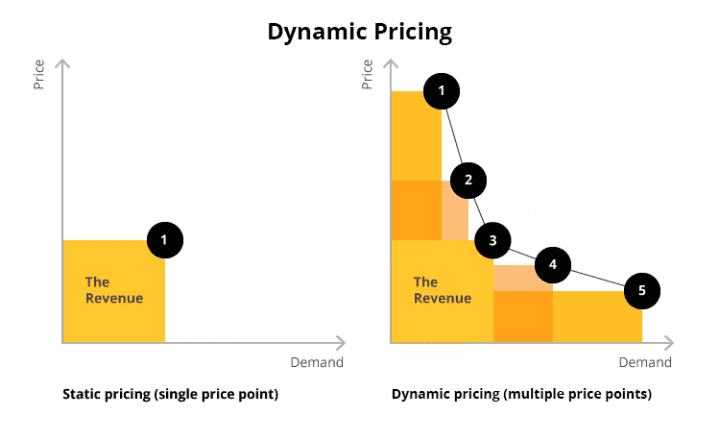
Pros:
As you implement a dynamic price model, you’ll start to understand your customers’ behavior better. This will give you access to data such as:
- Frequency and timing of purchases.
- The minimum and the maximum price that your customers are willing to pay.
- A detailed overview of the demand curve.
Cons:
A potential disadvantage of this method is that it can confuse or even anger customers if they discover that the product they bought for one price ends up costing less later due to dynamic price changes.
That said, you can set some limits to prevent overly dramatic fluctuations and to keep things accountable.
Pricing Strategies for Contested B2B Markets
Sometimes B2B companies face intense competition, whether it’s eCommerce or a B2B marketplace. In highly contested markets where industry-changing innovations and cost advantages aren’t possible, the secret to profits is smart pricing. When faced with almost debilitating market conditions, you must remember to manage for profits, not for market share. Managing for market share often results in price wars, depressed prices, and poached customers. No one wins.
A recent A.T. Kearney study of oligopolies found that leading companies focus less on maximizing their market share and more on maximizing their profits. These leaders don’t blindly attack by slashing prices. Instead, they strategically anticipate how their own customers would react to an attack by a competitor and then invest in strengthening customer relationships. The resulting customer relationships last 3 times longer and see 6% price hikes.
The takeaway is that when faced with a highly-contested market, resist slashing prices. Instead, understand your rival companies’ positions and how they may attack. Focus on protecting margins and territories by strengthening customer relationships. Understand your customer from all angles. Attack competitors less often and thoroughly understand all consequences of any attack. These tips will help you achieve higher profits and more stable growth.
5 Mistakes in B2B eCommerce pricing strategy
Now that you’ve learned about different B2B eCommerce pricing strategies, it’s time to develop your own. But before you start, let’s take a look at some B2B pricing best practices and common mistakes to avoid when pricing your products.
1. Inconsistent pricing across channels
Inconsistent pricing can create problems with how customers perceive your brand. For example, if you have products listed as high-end items on your website and then consistently offer them with a significant discount via specific marketing channels, your pricing strategy will not align across these channels.
When customers see products sold for vastly different prices, they get confused. At the very least, it will result in customers taking advantage of the channel with more attractive prices, impacting your bottom line.
To prevent this, it’s crucial to maintain a consistent strategy across all channels. Maintaining a minimum advertised price for eCommerce or direct sales is one way to ensure your every sales channel is competitive and profitable.
2. Offering unwarranted discounts
Discounting can be a great tactic to boost brand awareness and sales. However, discounting products without any logic behind it is a dangerous practice. It can condition your customers to expect discounts.
Instead, create a system for discounting on special occasions and focus on improving customer satisfaction.
3. Not segmenting customers
One of the biggest mistakes you can make regarding B2B eCommerce pricing is not to segment your customers. Without segmentation, you can’t create an experience tailored to each customer persona, which can limit your potential revenue.
A best practice approach is to create different customer groups to tailor the experience for each segment, for example, your returning customers vs. new customers.
4. Opportunistic pricing
Opportunistic pricing means pricing a product or service to take advantage of shifts in demand and supply. For example, some companies raised the cost of necessities to capitalize on demand during the pandemic outbreak. Raising product prices without any valid reason can make your customers lose trust in your company.
While there may be situations when prices must be raised for a specific reason, make sure to alert your customers as to the reasons why.
5. Not listing a price
Another thing to avoid is hiding the price of your products. Many B2B eCommerce brands decide not to show their prices so that competitors don’t know the cost of their products.
However, this can turn off customers as they need to do extra work to see if the price is even within their budget.
A good practice is to offer a “starting at” price point so that customers can determine if the products you’re selling are likely to fit their budget.
Support for Flexible B2B Pricing in OroCommerce
Ultimately, how well you can execute your pricing strategy depends on your eCommerce technology. Your platform should be flexible and dynamic enough to support complex B2B price management.
OroCommerce, an open-source B2B eCommerce platform, makes setting up different B2B pricing strategies easy. That’s because it comes with a built-in enterprise-grade pricing engine that calculates prices in real-time. Whether it’s value-based, dynamic, or another type of strategy, OroCommerce gives you the tools necessary to accommodate different pricing lists and tiers to support any approach to price setting.
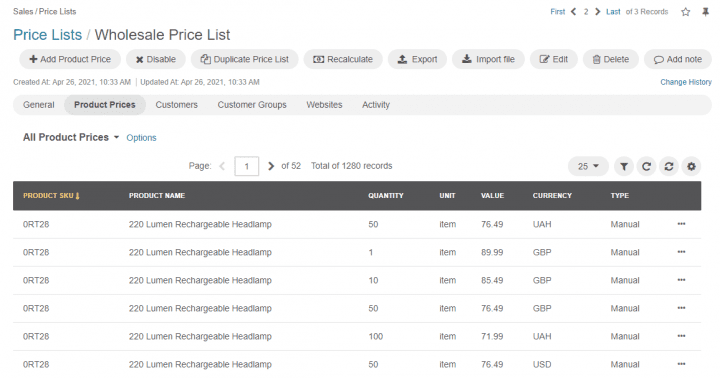
OroCommerce provides the flexibility to work with various pricing strategies, attributes, tiers, fallbacks, and price merging functions.
Here are just some of the things organizations can do with OroCommerce:
- Set up flexible prices for different websites, customer groups, and customers. For example, you can provide products with a discounted price for a specific customer type, like long-term customers; or you can set up the platform to show custom prices in Euros when your European clients buy in bulk.
- Assign prices for newly added products automatically. Save time by automatically generating a price or updating currency exchange rates for specific products using price calculation rules.
- Make the most use of dynamic pricing by scheduling price adjustments. Whether it’s a seasonal offer or a promotion campaign, you can display specific prices for your customers at scheduled times. Price scheduling helps you to manage prices more effectively, while eliminating the hassle of manual price changes.
Pricing Strategy and Technology: A Powerful Combo
Many B2B companies are not taking full advantage of B2B pricing strategies due to the complexity, ownership challenges, and perceived data barriers.
By embracing a flexible eCommerce platform, these challenges become a thing of the past. With comprehensive price-setting tools and access to crucial customer data, creating a profitable pricing strategy becomes easy, ensuring a solid foundation for sustainable growth.




